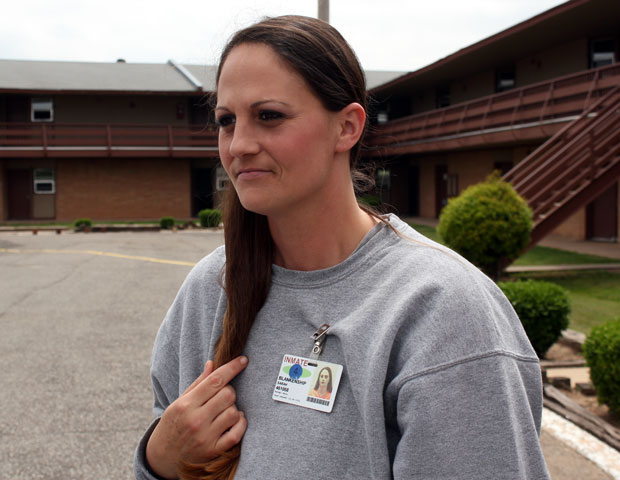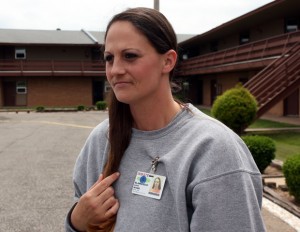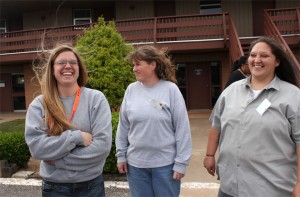
Caption
Joe Wertz / NPR/StateImpact


Caption
Joe Wertz / NPR/StateImpact

Joe Wertz / StateImpact Oklahoma
Inmate Sarah Blankenship stands outside the Kate Barnard Community Corrections Center in Oklahoma City.
Oklahoma’s rate of female incarceration is about twice the national average. The state has held on to its number one spot in that category for most of the past two decades.
It’s a distinction prison officials would rather not have, but isn’t easy to change. And there are unique challenges faced by women behind bars in Oklahoma.
“My name is Sheila White. I’m 45 years old, mother of three and have a grandchild. I was a drug addict. Have been often to drug addiction for 20 years. This is my third time in incarceration.”
What’s different about Sheila White’s prison experience this time is that she’s at the Kate Barnard Correctional Center in Oklahoma City, where up to 160 female inmates are allowed to hold jobs in the community as their release date approaches.
“My first two times, I never was able to come to lower security to a work release,” White says. “First time going out, stayed clean a year, but wasn’t nothing set up of this nature to help me; went right back to society and right back in again”
Now, after each workday, White reports back to prison. She only wishes this chance would have come sooner.
“I got a job. I’m working at an Indian buffet. For me, it’s a new beginning,” White says.
[module align=”right” width=”half” type=”pull-quote”]
“I Got a job. I’m working at an Indian buffet. For me, it’s a new beginning.”
[/module]
The Kate Barnard Correctional Center is actually a converted hotel. But the amenities are sparse. Four to 6 women to a room with little more than basic metal beds, a sink and toilet. It is still prison after all, and these women did commit crimes, mostly drug-related offenses.
“I’m Christine Rodriguez. I’ve been locked up since August 17, 2010. I have eight kids, one granddaughter.”
Rodriguez, like all the women here, can face the same challenges as men reentering society and more. The majority of women behind bars have minor children on the outside, according to the U.S. Department of Justice.
“They don’t visit, but I do get a letter from a couple of my children. They’re 21 and 18, and they write me,” Rodriguez says. “Then, I have a mother-in-law in El Paso, and she writes me too.”
Rodriguez’s incarceration increases the odds her children will perpetuate the cycle of crime and imprisonment. Justice Department research shows children of offenders are up to seven times more likely to be caught in the justice system than their peers. That negates the efforts of state prison officials and CareerTech administrators like Jim Meek.

Joe Wertz / StateImpact Oklahoma
Kate Barnard Inmate Christine Rodriguez, center, is looking for work while she finishes her drug trafficking sentence.
“Many of the female offenders will go back and they’re mom the day they get out. They may have one, two, three, four kids to take care of. There may not be a male figure there involved to help take care of them,” Meek says. “Grandma, mother, aunt has taken care of them and they’re tired and want relief. And so, not only do they have to earn a living. In addition, they have to figure out childcare issues, taking care of kids.”
It may be harder for men to find jobs once on the outside, but for women, the kind of job they get makes a difference.
“And many of them will just get out and take a low paying job for survival, work long, hard hours and never gain on this because they can’t get enough earning capacity to really take care of their family the way they need to take care of them,” Meeks says.
CareerTech has five programs at female corrections facilities, training women in a variety of industries, from office work to manufacturing. But Oklahoma has little tolerance for criminals, male or female.
In the last few years, lawmakers have passed laws to address the problem, including more support for electronic monitoring and shorter or alternative sentences for non-violent offenders. Still, the state Department of Corrections expects the number of women behind bars in Oklahoma to increase slightly in 2013 to nearly 2,700, once again putting Oklahoma near the top in female incarceration.